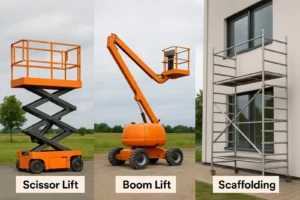
- Book Now:
- +1 647-525-7368+1 647-525-7368

Whether you’re renting a forklift, skid steer, or aerial lift, performing proper safety inspections before using rented equipment isn’t just a precaution—it’s essential. Every year in Canada, rental equipment-related accidents cost businesses thousands in fines, downtime, and injuries. To avoid these risks, you must follow a structured process built on trusted inspection practices. In this guide, you’ll learn how to perform effective equipment rental safety inspections that align with legal requirements, reduce hazards, and ensure reliability.
Pre-use equipment inspections in Canada are systematic checks performed before each use of rented equipment to ensure that it is safe, functional, and compliant with local safety standards (like CSA and OHSA regulations). These inspections are not only good practice—they’re often a legal requirement under provincial workplace safety laws.
Inspections help identify hidden issues such as leaks, worn-out parts, or improper maintenance. Catching these problems early can prevent costly breakdowns, protect operators, and ensure you’re not held liable for damages.
To cover all bases, your rented equipment safety checklist should include these core areas:
| Component | What to Inspect | Why It Matters |
| Undercarriage | Tracks, debris, visible cracks or wear | Stability and safe movement |
| Lights & Signals | Headlights, brake lights, hazard indicators | Visibility and legal compliance |
| Hydraulics | Hose integrity, leaks, reservoir levels | Prevents failure and costly repairs |
| Brakes & Tires | Pad wear, air pressure, tread condition | Essential for stopping power and control |
| Safety Features | ROPS, decals, horns, fire extinguishers | Protects operator in case of emergency |
| Controls | Levers, pedals, throttle, kill switch | Ensures full operational control |
| Documentation | Service logs, safety decals, rental agreements | Legal protection and accountability |
By checking these areas thoroughly, you reduce risk, extend equipment lifespan, and build a strong safety culture.
Here’s how to perform pre-use equipment inspections in Canada effectively:
Tip: Use a digital checklist app to save time and maintain consistency.
To improve inspection quality and traceability, Canadian rental companies and safety consultants recommend these tech tools:
This technology ensures inspections are standardized and can be easily audited.
In Canada, industry standards recommend:
Failing to perform routine rental equipment safety checks can result in denied insurance claims and regulatory fines.
In provinces like Ontario or British Columbia, employers are responsible for ensuring that competent individuals complete inspections.
If your inspection reveals damage, malfunction, or safety hazards:
Rental companies are typically responsible for repairs unless damage is caused by negligence.
Read: Scissor Lift Certification in Canada

| Feature | DIY Inspection | Third-Party Inspection |
| Cost | Low (time-based) | $75-$200 per machine |
| Compliance Level | Varies by user | Guaranteed with documentation |
| Liability Protection | Moderate | High |
| Speed | Immediate | Requires scheduling |
Third-party inspections are often preferred for heavy or hazardous equipment.
A robust safety program reduces accidents, lowers insurance premiums, and enhances productivity.
Conclusion
Conducting thorough equipment rental safety inspections is more than a checklist item—it’s a core component of a responsible and safe worksite. By following the guidance above, leveraging technology, and keeping accurate records, you not only meet legal standards but also create a culture of accountability.
At NAM Rentals (namrentals.com), we take pride in offering the highest-quality rental equipment across Canada, backed by professional inspection services and unmatched customer support. Our fleet is regularly maintained and safety-checked to meet and exceed Canadian standards.
Trust NAM Rentals—the leading equipment rental provider in Canada—to keep your operations moving safely and efficiently. Contact us today to learn more or request a rental!
Sign up to receive exclusive offers & updates.